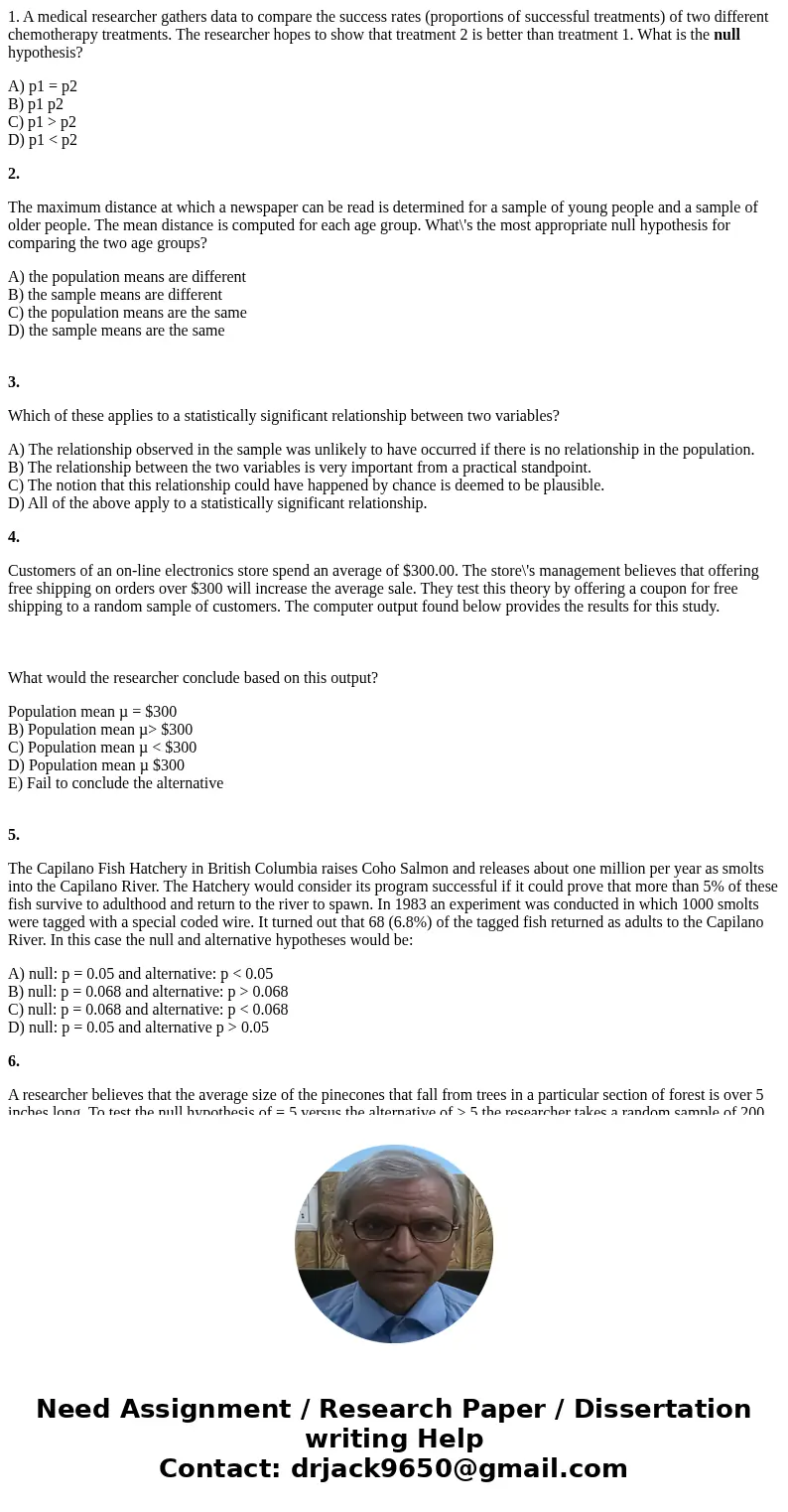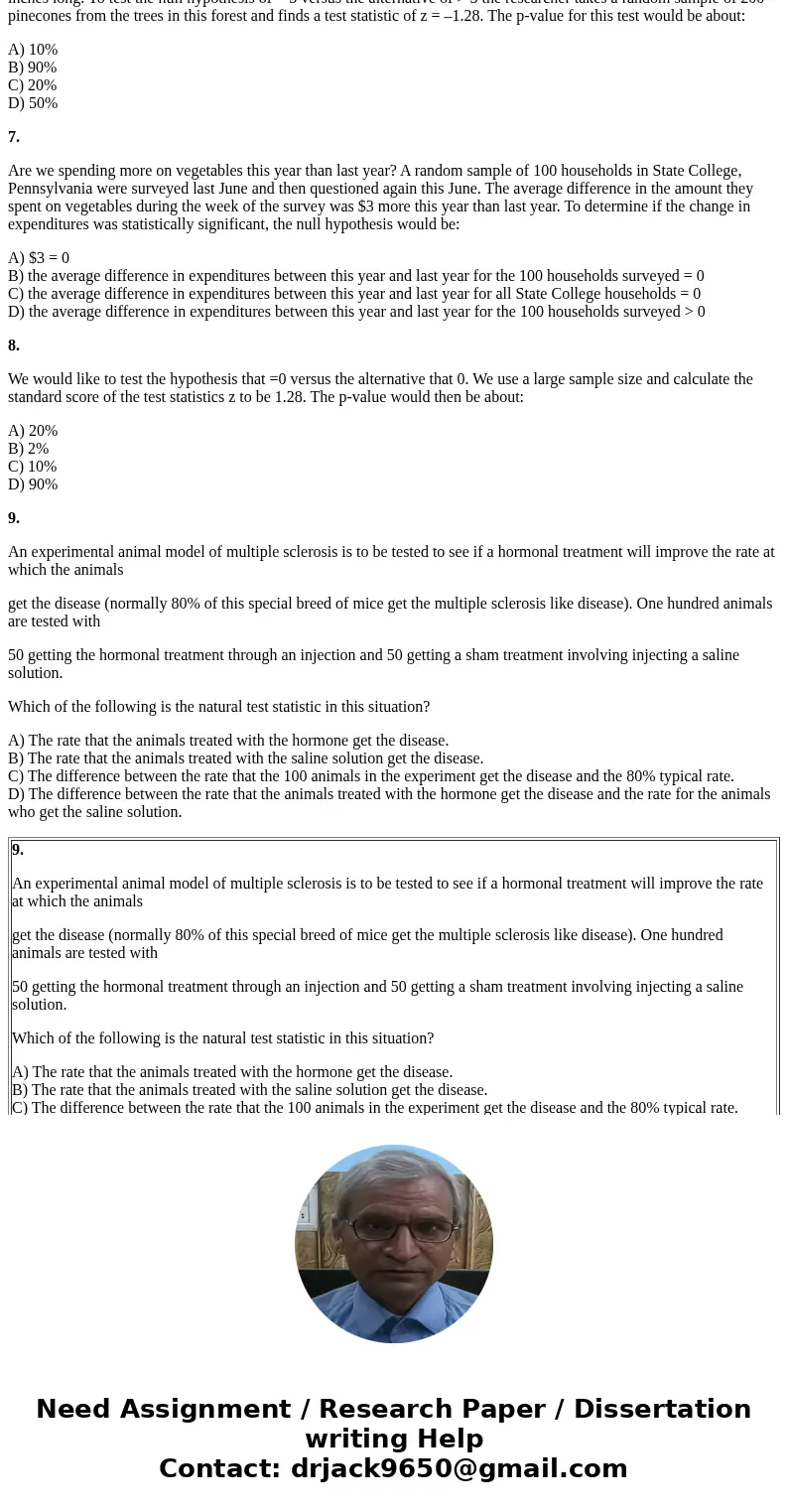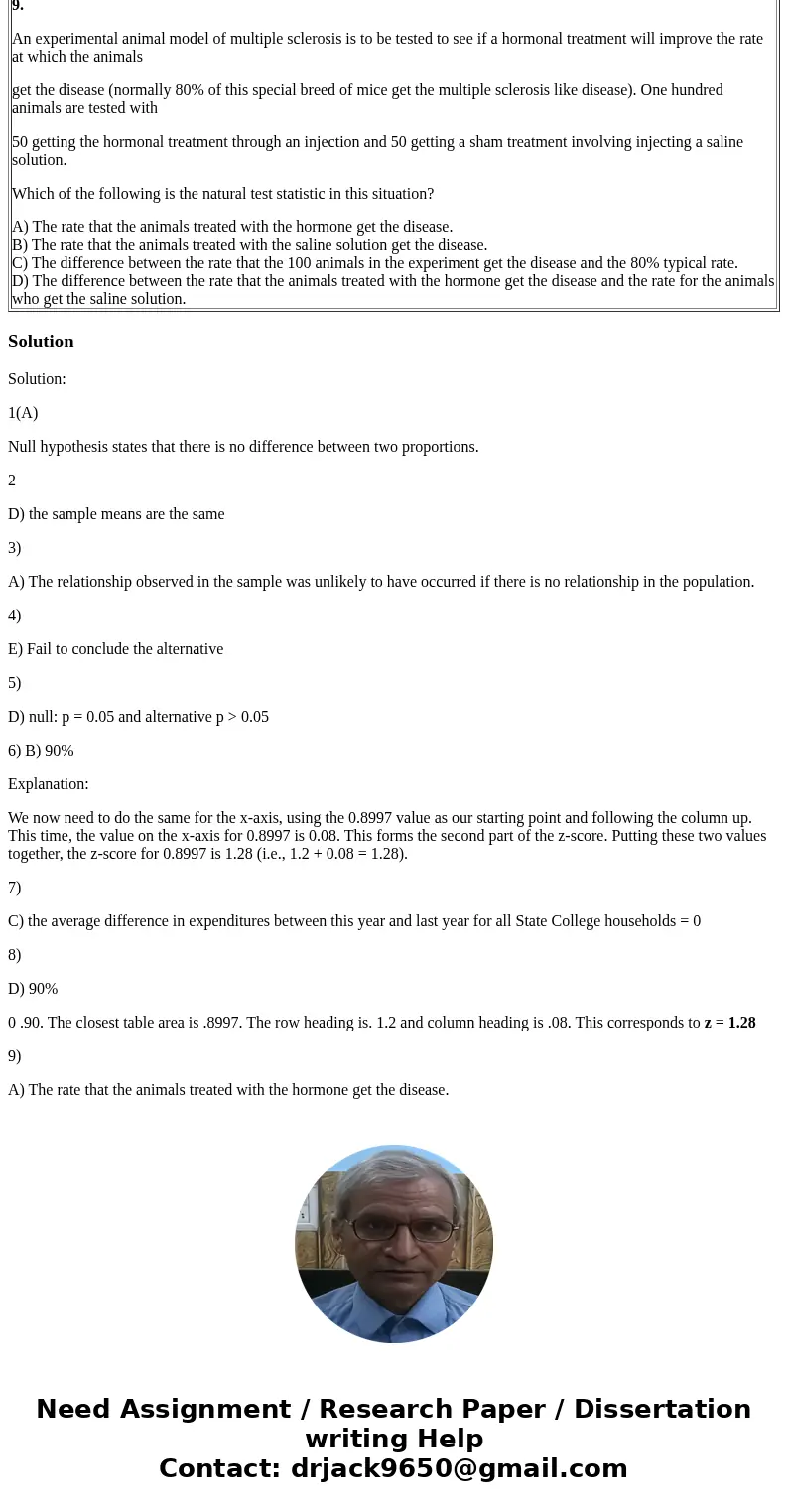1 A medical researcher gathers data to compare the success r
1. A medical researcher gathers data to compare the success rates (proportions of successful treatments) of two different chemotherapy treatments. The researcher hopes to show that treatment 2 is better than treatment 1. What is the null hypothesis?
A) p1 = p2
B) p1 p2
C) p1 > p2
D) p1 < p2
2.
The maximum distance at which a newspaper can be read is determined for a sample of young people and a sample of older people. The mean distance is computed for each age group. What\'s the most appropriate null hypothesis for comparing the two age groups?
A) the population means are different
B) the sample means are different
C) the population means are the same
D) the sample means are the same
3.
Which of these applies to a statistically significant relationship between two variables?
A) The relationship observed in the sample was unlikely to have occurred if there is no relationship in the population.
B) The relationship between the two variables is very important from a practical standpoint.
C) The notion that this relationship could have happened by chance is deemed to be plausible.
D) All of the above apply to a statistically significant relationship.
4.
Customers of an on-line electronics store spend an average of $300.00. The store\'s management believes that offering free shipping on orders over $300 will increase the average sale. They test this theory by offering a coupon for free shipping to a random sample of customers. The computer output found below provides the results for this study.
What would the researcher conclude based on this output?
Population mean µ = $300
B) Population mean µ> $300
C) Population mean µ < $300
D) Population mean µ $300
E) Fail to conclude the alternative
5.
The Capilano Fish Hatchery in British Columbia raises Coho Salmon and releases about one million per year as smolts into the Capilano River. The Hatchery would consider its program successful if it could prove that more than 5% of these fish survive to adulthood and return to the river to spawn. In 1983 an experiment was conducted in which 1000 smolts were tagged with a special coded wire. It turned out that 68 (6.8%) of the tagged fish returned as adults to the Capilano River. In this case the null and alternative hypotheses would be:
A) null: p = 0.05 and alternative: p < 0.05
B) null: p = 0.068 and alternative: p > 0.068
C) null: p = 0.068 and alternative: p < 0.068
D) null: p = 0.05 and alternative p > 0.05
6.
A researcher believes that the average size of the pinecones that fall from trees in a particular section of forest is over 5 inches long. To test the null hypothesis of = 5 versus the alternative of > 5 the researcher takes a random sample of 200 pinecones from the trees in this forest and finds a test statistic of z = –1.28. The p-value for this test would be about:
A) 10%
B) 90%
C) 20%
D) 50%
7.
Are we spending more on vegetables this year than last year? A random sample of 100 households in State College, Pennsylvania were surveyed last June and then questioned again this June. The average difference in the amount they spent on vegetables during the week of the survey was $3 more this year than last year. To determine if the change in expenditures was statistically significant, the null hypothesis would be:
A) $3 = 0
B) the average difference in expenditures between this year and last year for the 100 households surveyed = 0
C) the average difference in expenditures between this year and last year for all State College households = 0
D) the average difference in expenditures between this year and last year for the 100 households surveyed > 0
8.
We would like to test the hypothesis that =0 versus the alternative that 0. We use a large sample size and calculate the standard score of the test statistics z to be 1.28. The p-value would then be about:
A) 20%
B) 2%
C) 10%
D) 90%
9.
An experimental animal model of multiple sclerosis is to be tested to see if a hormonal treatment will improve the rate at which the animals
get the disease (normally 80% of this special breed of mice get the multiple sclerosis like disease). One hundred animals are tested with
50 getting the hormonal treatment through an injection and 50 getting a sham treatment involving injecting a saline solution.
Which of the following is the natural test statistic in this situation?
A) The rate that the animals treated with the hormone get the disease.
B) The rate that the animals treated with the saline solution get the disease.
C) The difference between the rate that the 100 animals in the experiment get the disease and the 80% typical rate.
D) The difference between the rate that the animals treated with the hormone get the disease and the rate for the animals who get the saline solution.
| 9. An experimental animal model of multiple sclerosis is to be tested to see if a hormonal treatment will improve the rate at which the animals get the disease (normally 80% of this special breed of mice get the multiple sclerosis like disease). One hundred animals are tested with 50 getting the hormonal treatment through an injection and 50 getting a sham treatment involving injecting a saline solution. Which of the following is the natural test statistic in this situation? A) The rate that the animals treated with the hormone get the disease. |
Solution
Solution:
1(A)
Null hypothesis states that there is no difference between two proportions.
2
D) the sample means are the same
3)
A) The relationship observed in the sample was unlikely to have occurred if there is no relationship in the population.
4)
E) Fail to conclude the alternative
5)
D) null: p = 0.05 and alternative p > 0.05
6) B) 90%
Explanation:
We now need to do the same for the x-axis, using the 0.8997 value as our starting point and following the column up. This time, the value on the x-axis for 0.8997 is 0.08. This forms the second part of the z-score. Putting these two values together, the z-score for 0.8997 is 1.28 (i.e., 1.2 + 0.08 = 1.28).
7)
C) the average difference in expenditures between this year and last year for all State College households = 0
8)
D) 90%
0 .90. The closest table area is .8997. The row heading is. 1.2 and column heading is .08. This corresponds to z = 1.28
9)
A) The rate that the animals treated with the hormone get the disease.



 Homework Sourse
Homework Sourse